Mastering Gray Walls: The Ultimate Guide to Choosing Perfect Curtain Colors
Gray walls are a cornerstone of modern interior design, cherished for their incredible versatility and sophisticated appeal. Yet, this very flexibility can make choosing the right curtain color feel like a daunting task. You might find yourself staring at your beautifully painted gray walls, wondering which shade will truly complete the room without clashing or appearing bland. Whether your space leans cozy, sleek, bright, or moody, finding that perfect curtain match is key to tying your decor together.
This comprehensive guide will demystify the process, offering a wealth of curtain color ideas that beautifully complement gray walls. We’ll delve into helpful styling tips to elevate your design and highlight common mistakes to avoid, ensuring you select curtains with confidence and create a truly harmonious living space.
Understanding Gray Walls: A Versatile Backdrop
Gray’s popularity stems from its unique ability to act as a neutral canvas, offering a serene backdrop for almost any color palette. This means you have remarkable freedom when selecting curtains – from light, airy tones to deep, dramatic hues, and even bold, vibrant shades. The secret to success lies not in finding a single “best” color, but in choosing curtains that align with the specific mood, purpose, and existing elements of your room.
For instance, soft neutrals like crisp white or creamy ivory can instantly brighten a room, making it feel more expansive and inviting. Conversely, darker shades such as charcoal gray or sophisticated navy can introduce depth and a sense of luxury. If you’re aiming for a warm, earthy atmosphere, consider hues like olive green or rich brown. For those who love a playful touch, light pink or eye-catching patterned curtains can inject personality and fun.
Beyond color, consider the room’s natural lighting. A space with limited natural light will benefit immensely from lighter curtains that reflect ambient light, enhancing brightness and creating an open feel. Conversely, sun-drenched rooms can comfortably accommodate darker, more saturated curtain colors, allowing them to make a bold statement without overwhelming the space. With a little foresight and careful consideration, you can easily find curtains that not only complement but also beautifully enhance the inherent elegance of your gray walls.
Best Curtain Colors for Gray Walls: 17 Stunning Ideas
Transforming a gray-walled room from merely functional to exquisitely stylish often begins with the right curtain choice. Whether your preference is for soft neutrals, deeply saturated tones, or vibrant, playful hues, there’s a perfect curtain color waiting to harmonize with your gray walls. Explore these carefully curated options, each designed to blend beautifully with various shades of gray and cater to diverse tastes and interior styles.
1. White Curtains
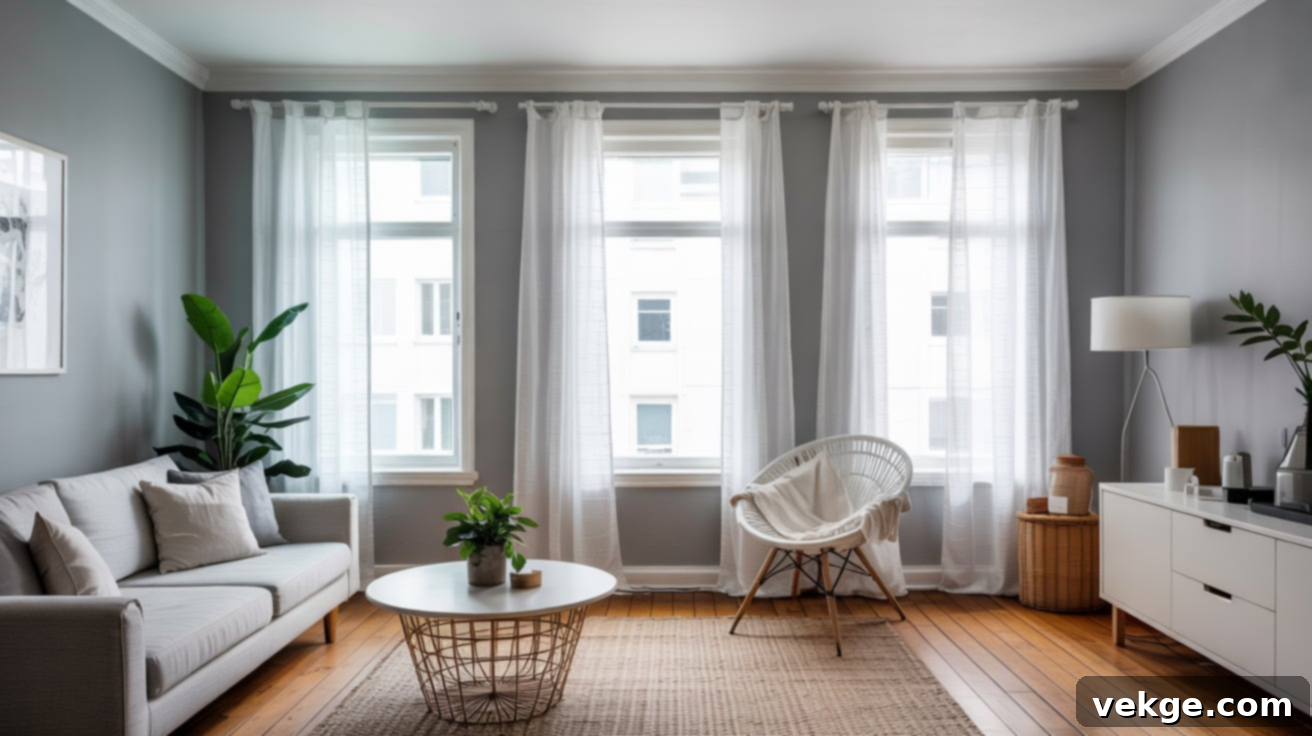
White curtains are an iconic and universally loved pairing for gray walls. This classic combination instantly brightens any space, making it feel impeccably clean, fresh, and exceptionally airy. It’s a go-to choice for modern, minimalist, or Scandinavian-inspired rooms, where simplicity and light are paramount.
White fabric excels at reflecting natural light, a valuable asset that helps smaller rooms feel significantly more open and spacious. For gray walls with cooler undertones, crisp, brilliant white curtains will enhance their sleek, contemporary edge. If your gray leans warmer, consider off-white or an antique white for a softer, more balanced aesthetic that still maintains brightness.
For added versatility and style, layer white sheers beneath heavier white drapes. This approach offers both functional flexibility (light filtering vs. privacy) and visual depth. The clean simplicity of white curtains also provides a neutral foundation, allowing you to introduce bolder colors and textures through furniture, artwork, or decorative accents without visual clutter.
2. Charcoal Gray Curtains
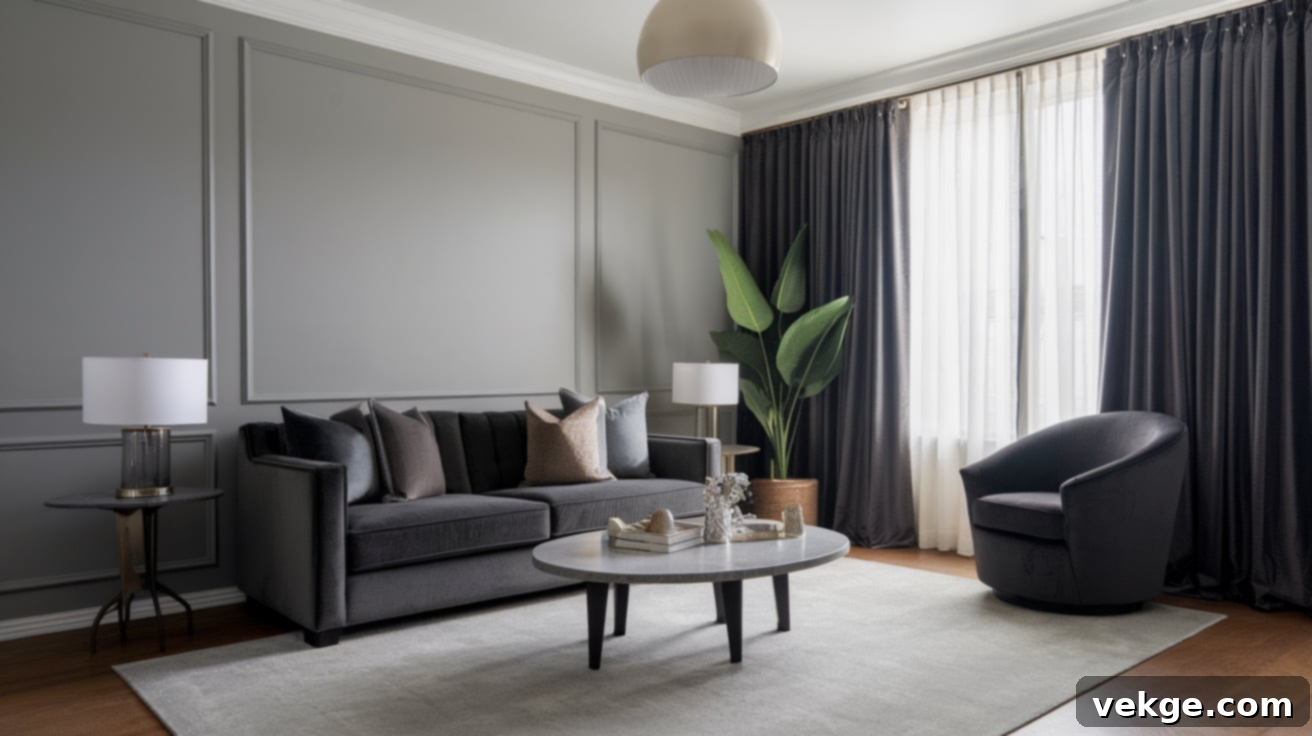
Opting for charcoal gray curtains creates a sophisticated monochromatic look that exudes sleekness and high-end appeal. This choice works exceptionally well with light to medium gray walls, adding profound visual depth and a sense of layered luxury without introducing any contrasting colors. This tonal arrangement is ideal for achieving a polished, contemporary, or modern aesthetic.
The texture of your fabric can dramatically alter the feel: a plush velvet or heavy wool offers a truly luxurious and dramatic effect, while lightweight materials like linen or cotton provide a softer, more understated touch. To prevent the room from feeling too uniform or flat, introduce carefully selected accent colors through throw pillows, area rugs, or striking wall art. This allows for subtle pops of color that break up the gray without disrupting the cohesive palette.
Charcoal gray curtains are the perfect choice if you appreciate clean lines, a refined ambiance, and a beautifully coordinated design scheme that feels effortlessly chic.
3. Lavender Curtains
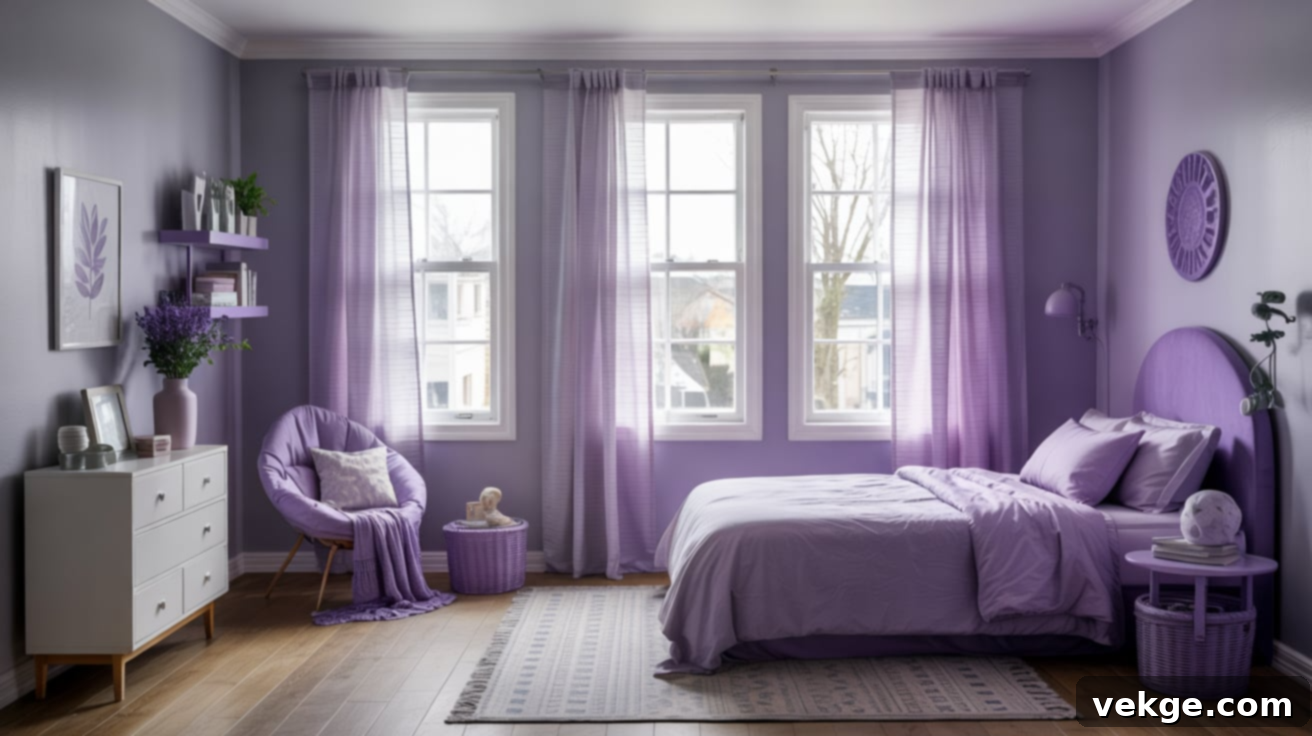
Lavender curtains infuse any room with gray walls with a wonderfully calming, gentle, and serene atmosphere. This delicate shade of purple harmonizes exquisitely with soft or cool-toned grays, making it an ideal choice for tranquil spaces such as bedrooms, nurseries, or quiet reading nooks where relaxation is key.
Lavender introduces just the right amount of subtle color to create visual interest without being overpowering, maintaining a soft and peaceful vibe. It’s particularly effective in creating feminine spaces, soothing nurseries, or intimate corners designed for repose. To further enhance this delicate aesthetic, incorporate metallic accents like silver or muted gold, or pair with other soft pastels and pristine white elements.
The combination of lavender and gray feels distinctly modern yet retains a delightful sense of delicacy and charm, creating an inviting and tranquil sanctuary.
4. Chambray Blue Curtains
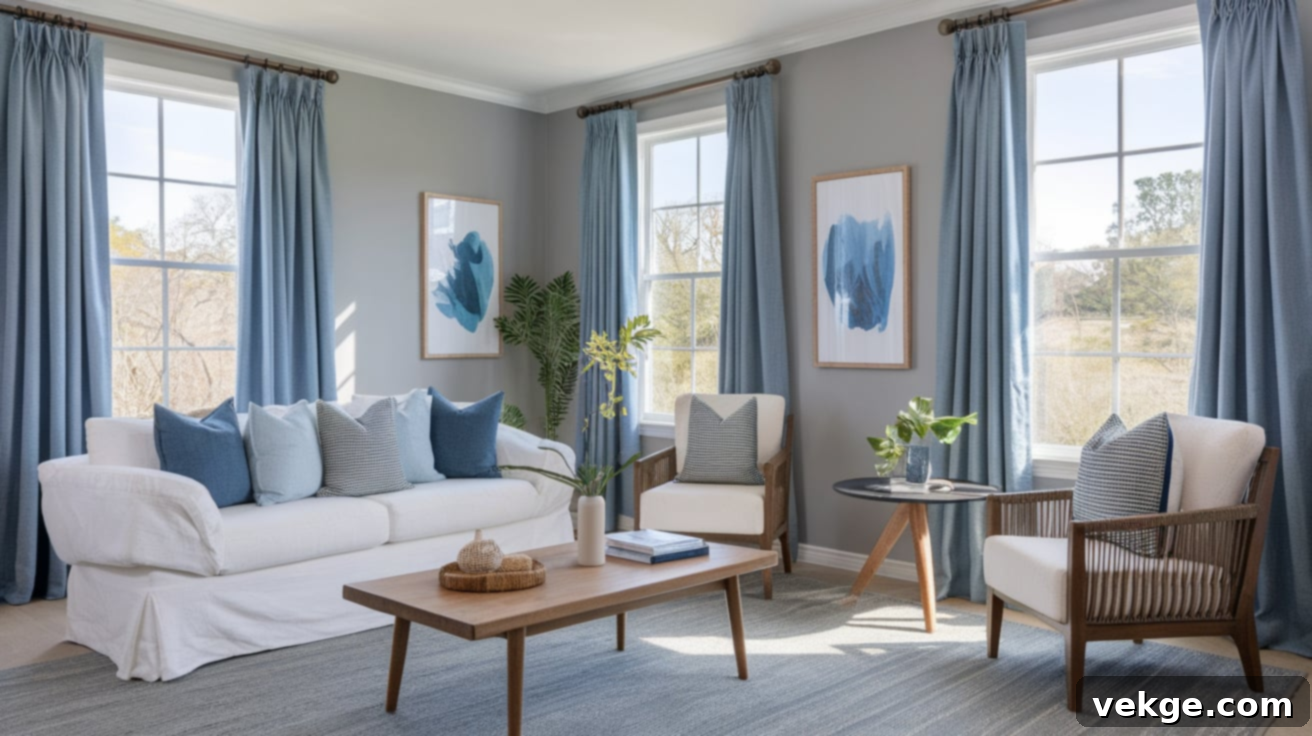
Chambray blue curtains offer a relaxed, laid-back aesthetic that pairs wonderfully with gray walls, evoking a sense of effortless comfort. The muted, denim-like tone of chambray keeps the atmosphere casual and approachable while introducing sufficient color to prevent monotony and add a refreshing touch.
This shade is an excellent choice for cozy living rooms, welcoming guest rooms, or spaces inspired by a coastal or casual farmhouse theme. Chambray blue looks particularly striking against light gray walls, contributing to a cool, refreshing, and open feel within the room. Often found in natural materials like cotton or linen, chambray curtains enhance the overall sense of a lived-in, comfortable space.
To perfect this relaxed look, integrate warm wooden accents, woven textures like jute rugs or rattan furniture, and simple, natural decor. This pairing creates an inviting, unpretentious environment that feels both stylish and wonderfully serene.
5. Olive Green Curtains
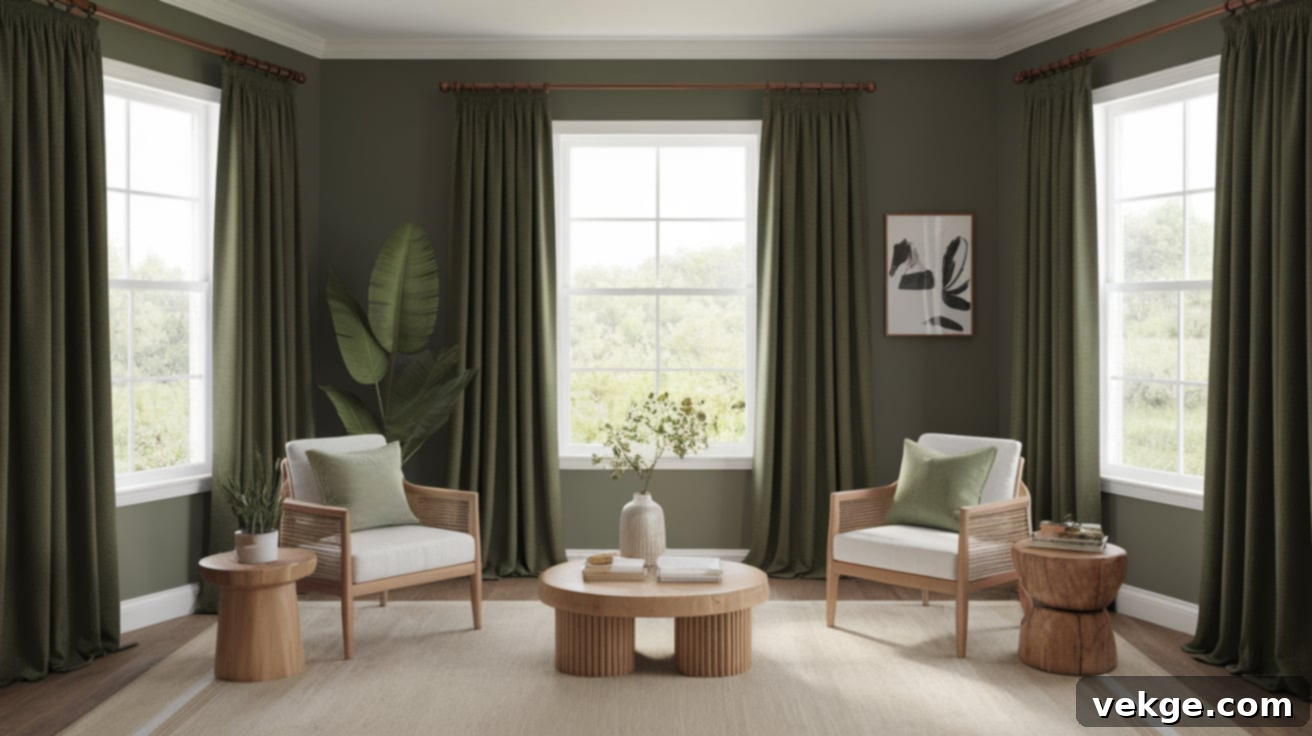
Olive green curtains infuse any room with gray walls with rich warmth and a grounding earthiness. This creates a beautifully organic contrast that feels natural and deeply rooted, especially when paired with cooler shades of gray. Olive is a fantastic choice for rustic, farmhouse, or boho-inspired interiors, where a connection to nature and a cozy ambiance are desired.
This sophisticated green adds significant depth to your space without being overly bold, making it a versatile color that transitions beautifully throughout the seasons. To complete the room’s natural aesthetic, incorporate a variety of natural textures such as reclaimed wood furniture, soft leather accents, and woven jute or sisal elements. The subtle green undertones inherent in olive curtains expertly soften the sometimes-cool backdrop of gray, helping to forge a perfectly balanced and genuinely inviting atmosphere.
6. Soft Pink Curtains

Soft pink curtains introduce a gentle, playful, and undeniably charming touch to gray walls, making them an ideal selection for feminine bedrooms, adorable nurseries, or light-hearted living spaces. The delicate contrast between a muted pink and a cool gray creates a look that is both fresh and deeply appealing, balancing softness with contemporary sophistication.
This pairing achieves a modern yet incredibly cozy feel. Shades like blush pink, dusty rose, or even a hint of peach work best, offering warmth without being saccharine. Enhance the warmth by pairing them with metallic accents such as gold or brass, or with soft ivory elements. To ensure the room doesn’t feel overly sweet, strategically incorporate neutral-toned furniture and clean-lined decor. This approach allows you to introduce a lovely pop of color and personality without overwhelming the space, maintaining a sophisticated balance.
7. Ivory Curtains
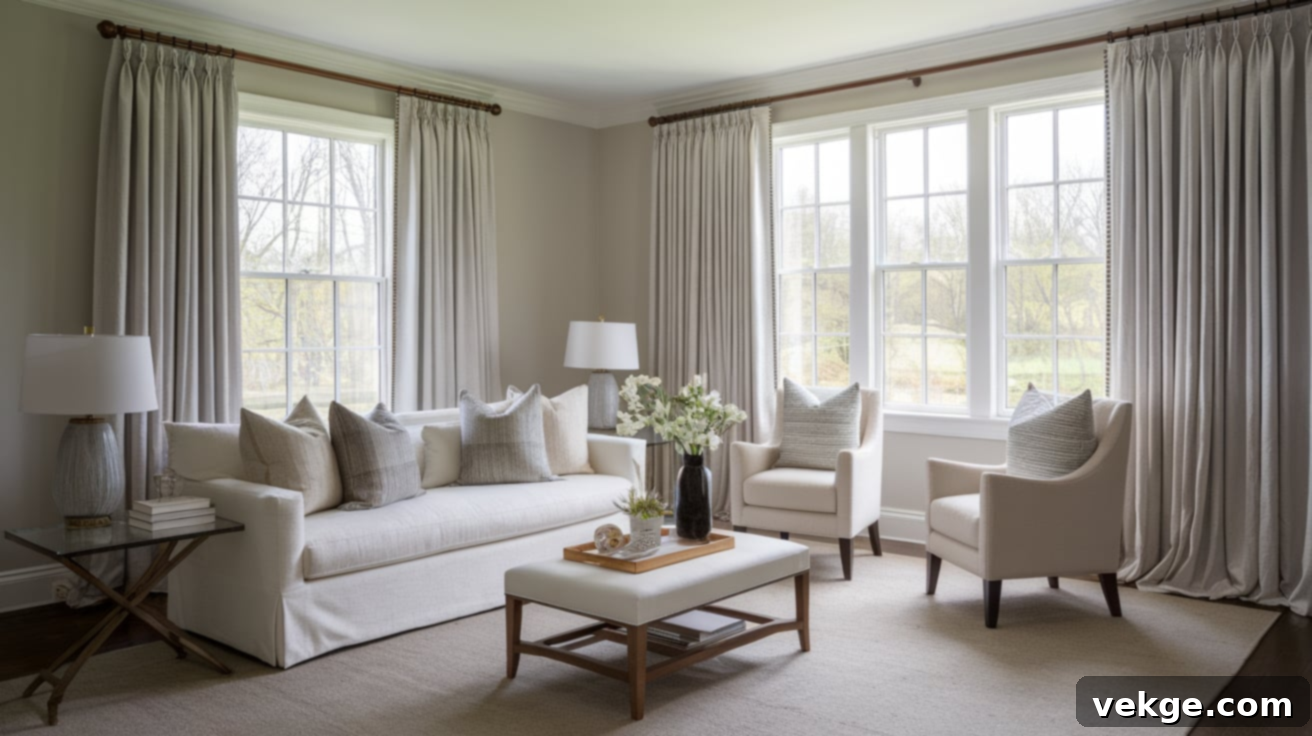
Ivory curtains stand as a supremely flexible and reliably elegant choice, blending seamlessly with virtually every shade of gray. Being slightly warmer than stark white, ivory offers a softer, more traditional, and inviting aesthetic. This makes them perfectly suited for classic interiors, transitional spaces, or any room where a harmonious balance between warm and cool tones is desired.
Ivory curtains perform exceptionally well in rooms that feature existing beige or natural wood accents, as their warm undertones beautifully connect these elements. They effectively reflect light, contributing to a brighter room, while maintaining a cozy and understated elegance. To add visual interest without overpowering the subtle charm of ivory, opt for curtains in textured fabrics such as slub linen, raw silk, or cotton weaves. This creates depth and character, ensuring the space feels rich and inviting without being overly dramatic.
8. Patterned Blue and White Curtains
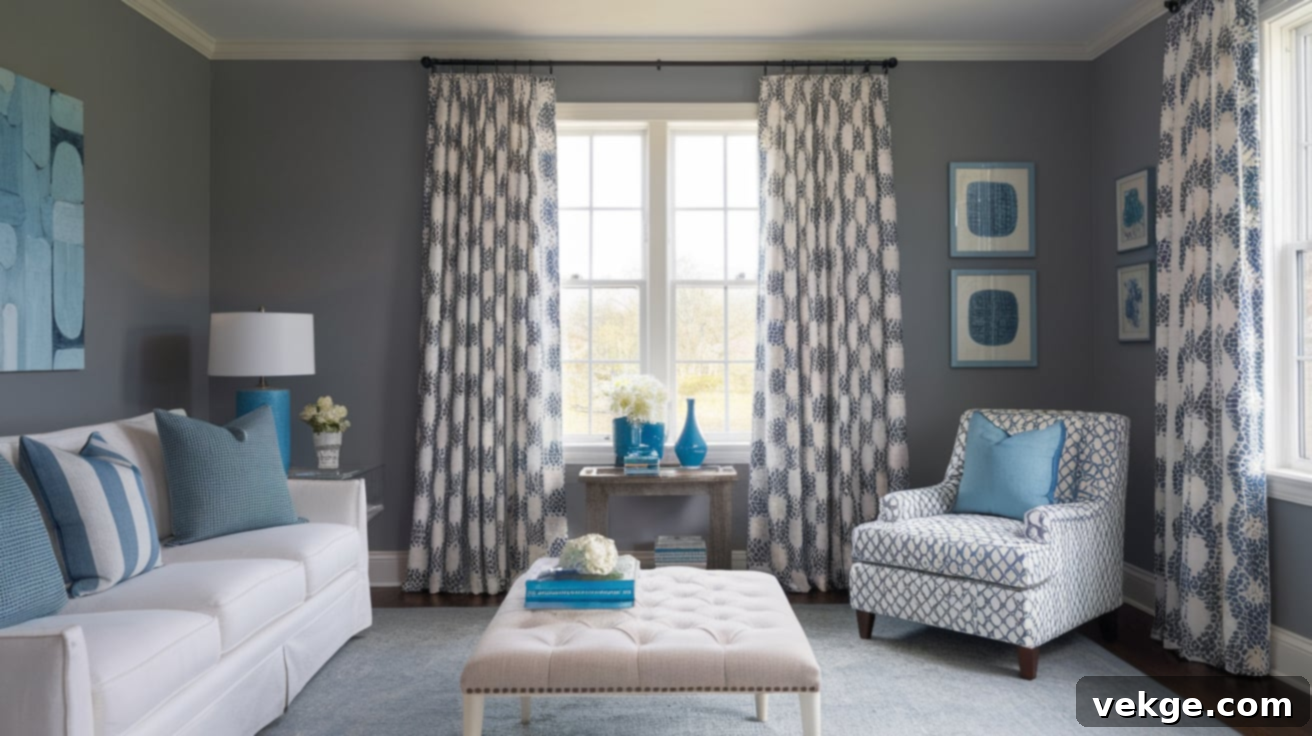
Patterned blue and white curtains are an excellent way to inject personality and vibrant character into a gray room without any risk of clashing. These curtains are ideally suited for casual and inviting spaces, such as lively living rooms, cheerful playrooms, or serene, beach-style bedrooms. The blue elements within the pattern provide a refreshing splash of color, while the white components tie the design back to a neutral, grounding base.
Whether you choose classic stripes, delicate florals, bold geometric prints, or whimsical abstract designs, these patterns keep the overall aesthetic fun, dynamic, and visually engaging. Against the calm backdrop of gray walls, this combination feels wonderfully fresh and incredibly inviting. For a more layered and sophisticated look, combine these patterned curtains with solid tiebacks or valances to add extra depth and polish.
Don’t hesitate to echo the blue tones from your curtains in other decor elements, such as throw pillows, decorative accents, or even subtle patterns in rugs. This creates a cohesive, thoughtfully designed space that feels both vibrant and unified.
9. Textured Brown Curtains

Textured brown curtains offer profound warmth and rich depth, establishing them as a remarkably smart choice for gray walls, particularly in rustic, industrial, or boho-inspired interiors. Browns featuring woven, linen-like, or even chunky knit textures bring an undeniable natural charm and effectively soften the often-cool demeanor of gray, creating a more inviting atmosphere.
Seek out rich, earthy tones such as deep cocoa, warm mocha, or sophisticated walnut to achieve a striking yet harmonious contrasting effect. This curtain style truly shines in living rooms, dens, or studies—any space where you desire a cozy, grounded, and welcoming feel. Elevate the organic appeal by layering with complementary natural elements like woven baskets, solid wooden furniture, soft faux fur throws, or jute rugs. These additions tie everything together in a beautifully cohesive and naturally inspired way.
10. Brown and White Curtains
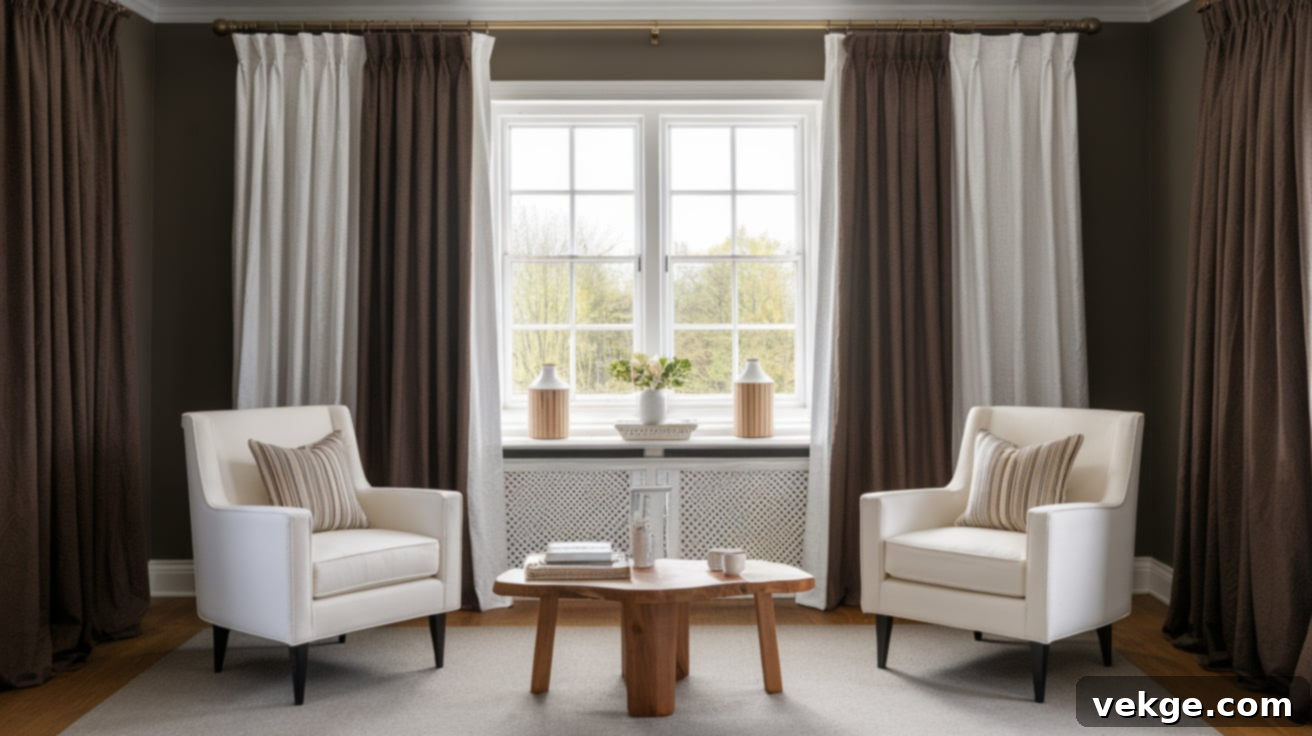
Brown and white curtains create a delightful two-tone effect that captures attention without overpowering the room. The elegant contrast between warm brown and crisp white truly pops against mid- to dark gray walls, offering a balanced visual interest. This look is perfectly suited for traditional, cottage, or modern farmhouse aesthetics, blending classic charm with contemporary appeal.
This dynamic combination feels grounded and stable, yet simultaneously light and fresh, offering a beautiful mix of rustic charm and practical elegance. Consider designs featuring vertical stripes to visually elongate the room, or choose subtle patterns that incorporate both hues for added texture. Pair these curtains with natural wooden accents, warm metallic fixtures, and neutral-toned furniture to create a complete, cohesive, and inviting space that feels both refined and comfortable.
11. Mustard Yellow Curtains
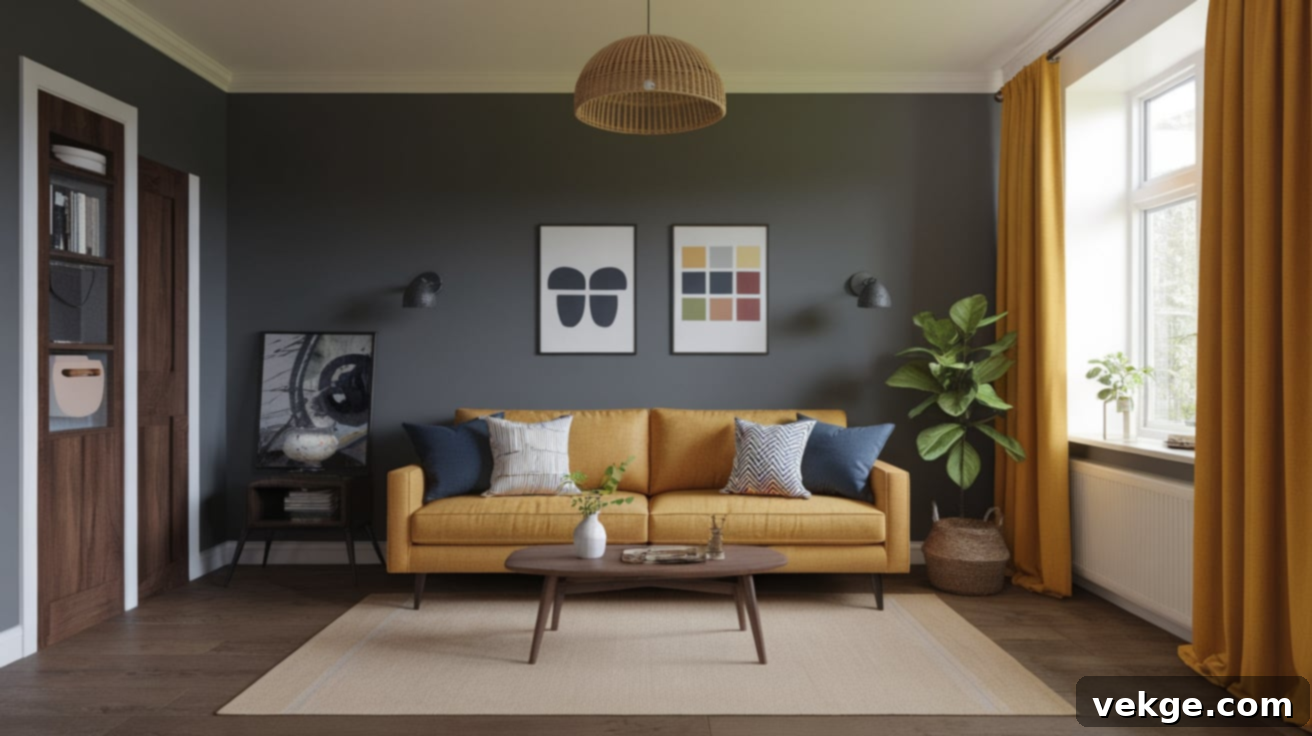
Mustard yellow curtains infuse gray-walled rooms with a bold, cheerful, and incredibly vibrant energy. The rich, warm tones of mustard beautifully contrast with cool or neutral grays, resulting in a balanced yet lively aesthetic that demands attention. This color is exceptional for injecting personality into living rooms, kitchens, or eclectic bedrooms, creating an undeniably spirited atmosphere.
It works particularly well in mid-century modern or retro-inspired interiors, where its vintage charm truly shines. Mustard also looks fantastic when paired with complementary colors such as deep navy, earthy olive green, or rich walnut wood tones, creating a sophisticated and energetic palette. To prevent this vivid shade from feeling too overwhelming or “loud,” use it in rooms that receive abundant natural light, or balance its intensity by keeping the rest of the decor in subdued, neutral shades. This ensures a joyful pop of color without chaos.
12. Terracotta Curtains
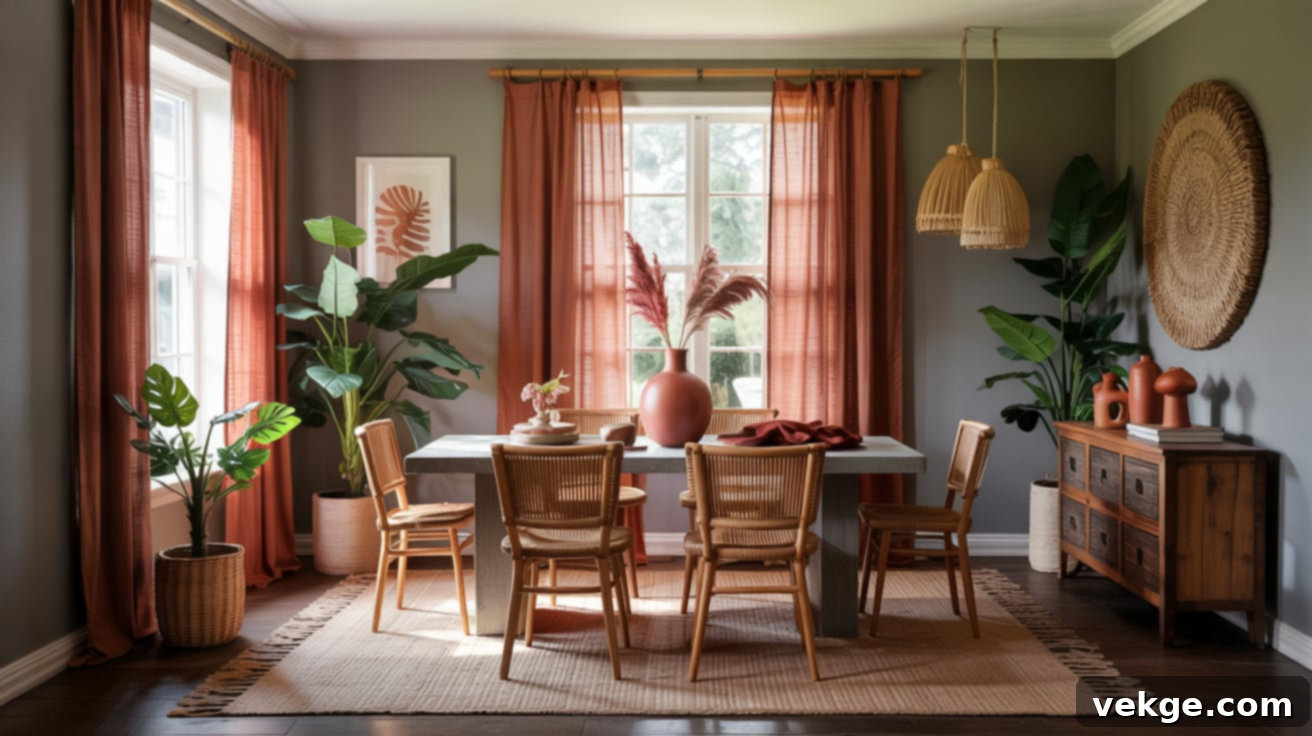
Terracotta curtains introduce a rich, earthy, and wonderfully grounded vibe that instantly warms up gray walls. This distinctive reddish-brown shade feels incredibly cozy and deeply comforting, making it an ideal choice for fall-inspired decor, bohemian aesthetics, or any interior aiming for a natural, rustic feel. Terracotta harmonizes exceptionally well with soft or medium gray walls, where its warmth can truly shine.
It creates a welcoming and profoundly comforting mood, pairing beautifully with a range of natural elements: think woven textures like macrame or jute, supple leather accents, and lush indoor greenery. Utilize terracotta curtains in living rooms, dining spaces, or even home offices to achieve a relaxed yet undeniably stylish ambiance. If you are drawn to nature-inspired color palettes and desire a space that feels both inviting and chic, this pairing is an absolute must-try.
13. Mint Green Curtains
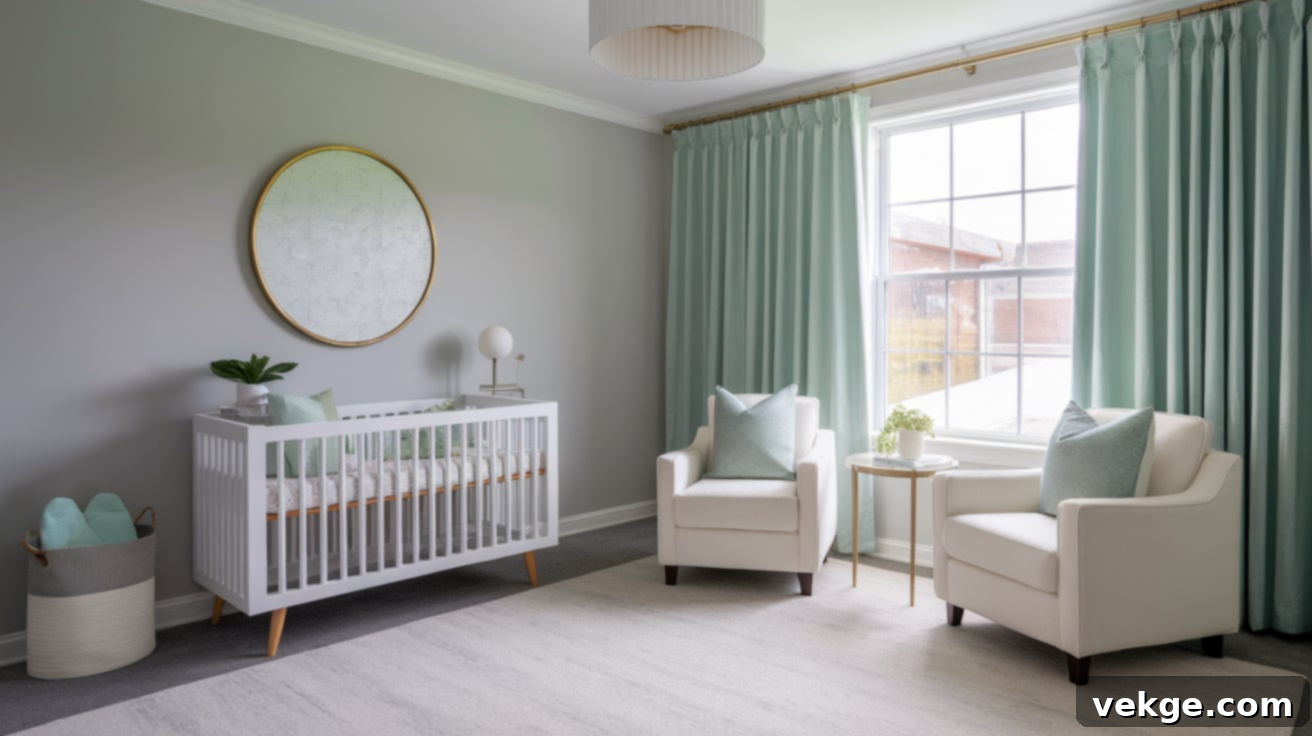
Mint green curtains offer a refreshing, unexpected, and utterly charming match for gray walls. This soft, pastel green brings a playful, youthful energy to a room without ever feeling overwhelming. It performs best with light or cool-toned grays, introducing a fresh and modern twist to nurseries, children’s rooms, or innovative, contemporary spaces that benefit from a subtle color infusion.
Mint green also beautifully complements white furniture, natural light-toned wood, and elegant gold or brass hardware, creating a bright and inviting scheme. It’s an ideal choice if you wish to introduce color and a sense of vitality without resorting to bold, saturated hues. The gentle contrast created by mint green ensures the room remains light, airy, and effortlessly easy to personalize, making it a versatile and delightful design element.
14. Silver Curtains
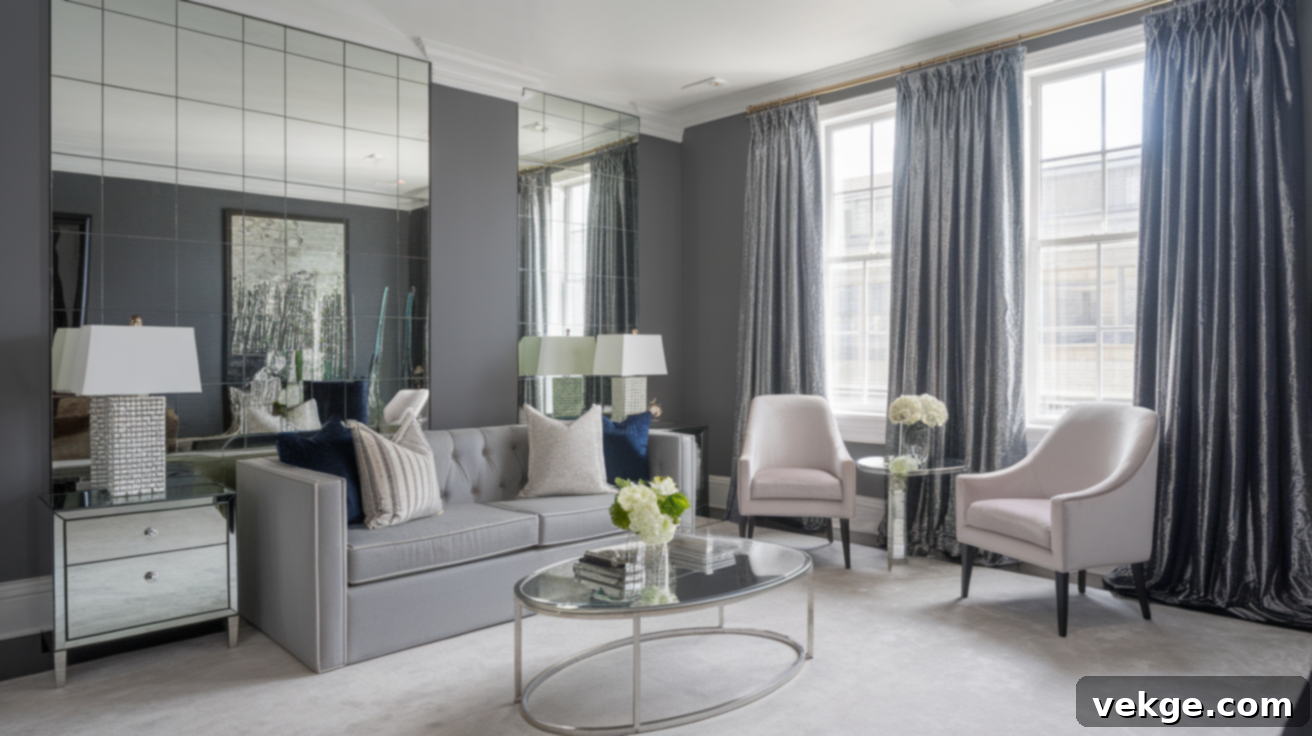
Silver curtains provide a sleek, refined, and distinctly sophisticated appearance that pairs flawlessly with gray walls. This elegant metallic shade instantly elevates a room’s glam factor while maintaining remarkable consistency within the overall color palette. Silver’s inherent reflective qualities make rooms feel brighter, more luminous, and noticeably more spacious, particularly beneficial in smaller or naturally dimmer areas.
It is the perfect choice for modern, glamorous, or even Art Deco-inspired interiors, where a touch of shimmer and luxury is desired. To cultivate a truly cohesive and opulent space, pair silver curtains with mirrored furniture, sparkling glass accents, and plush textiles like sumptuous velvet or luxurious faux fur. This curtain selection adds a significant layer of polish and refinement without straying too far from the foundational gray base, creating an atmosphere of understated glamour.
15. Navy Blue Curtains
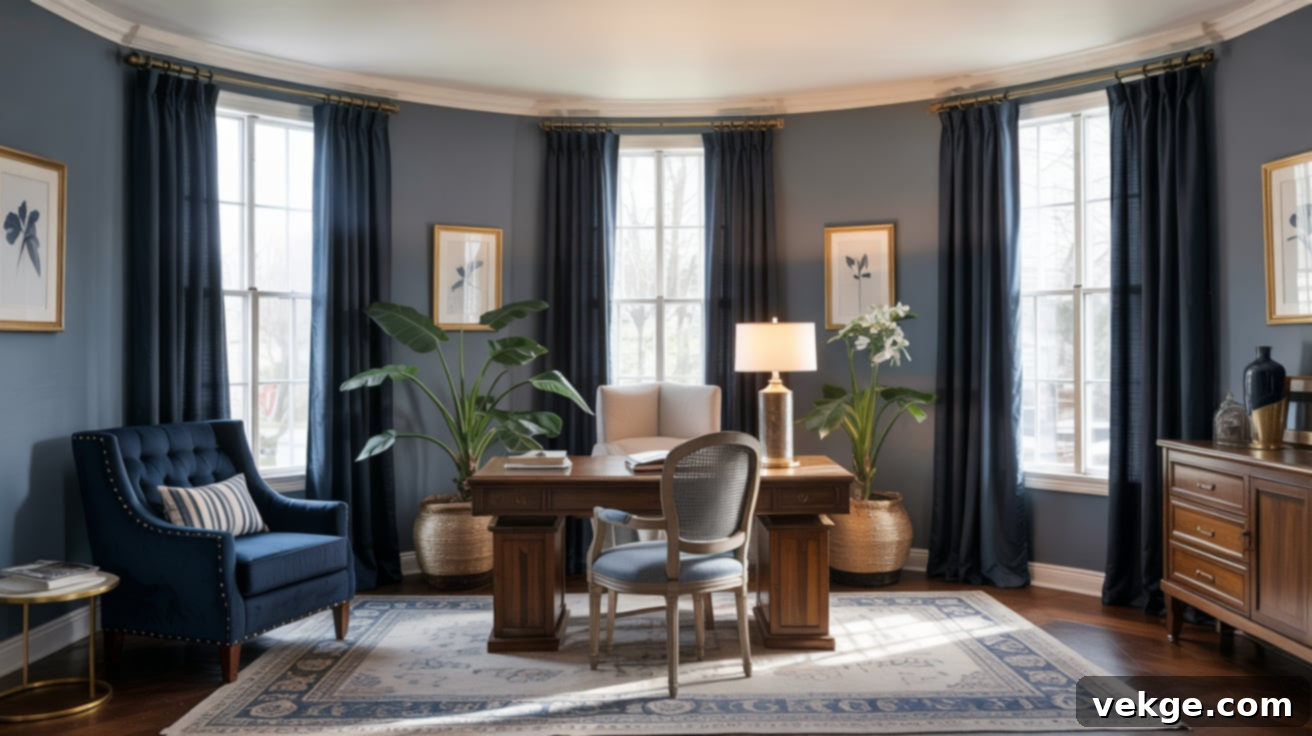
Navy blue curtains are a timeless and classic choice that injects considerable depth, sophistication, and a touch of drama into gray-walled rooms. This rich, deep hue works particularly well with both light and medium grays, offering a striking yet balanced contrast that enhances the space without ever feeling overpowering. Navy is the quintessential color for creating sophisticated interiors, making it perfect for elegant home offices, formal dining rooms, or luxurious master bedrooms.
It also beautifully complements pristine white trim, gleaming gold accents, or warm natural wood furniture, creating a well-rounded and refined aesthetic. To prevent the room from feeling too dark or enclosed, ensure there is ample natural and artificial lighting. Incorporate lighter-colored fabrics in other elements, such as throw blankets or rugs, to maintain an open and inviting feel, balancing the deep richness of the navy.
16. Multicolor Curtains
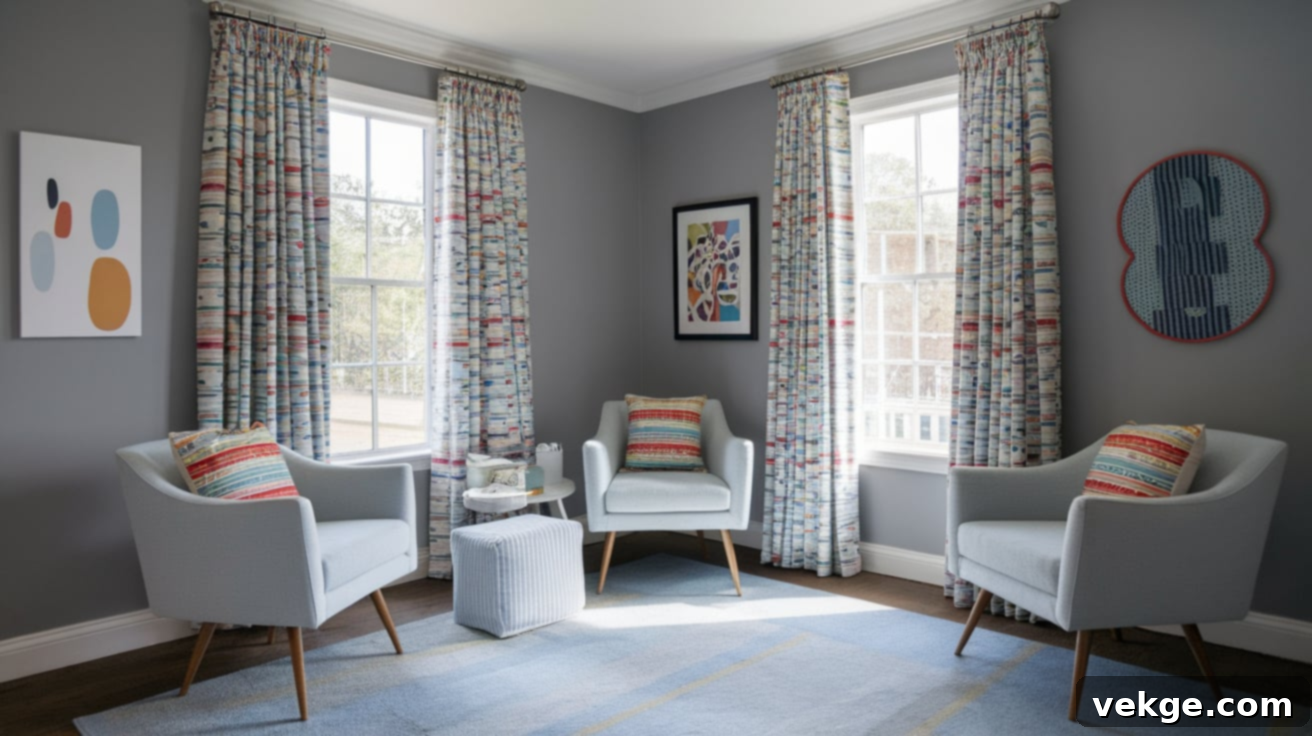
Multicolor curtains are the ideal solution for adding vibrant energy, playful fun, and distinct personality to a room with gray walls. Whether they feature bold stripes, cheerful florals, whimsical abstract designs, or intricate geometric patterns, multicolored curtains bring undeniable life and character into any space. These expressive curtains work exceptionally well in children’s rooms, creative playrooms, or eclectic-style homes where individuality and joy are celebrated.
The neutrality of gray walls is a key advantage here; it helps to tone down the vibrancy of the patterns, ensuring the colors feel exciting and dynamic without becoming chaotic or overwhelming. You can cleverly use the colors present in the curtain pattern as inspiration for other decor elements, such as accent throw pillows, area rugs, or wall art. This creates a beautifully playful, cohesive, and unified look that reflects a lively personality.
17. Ecru Curtains
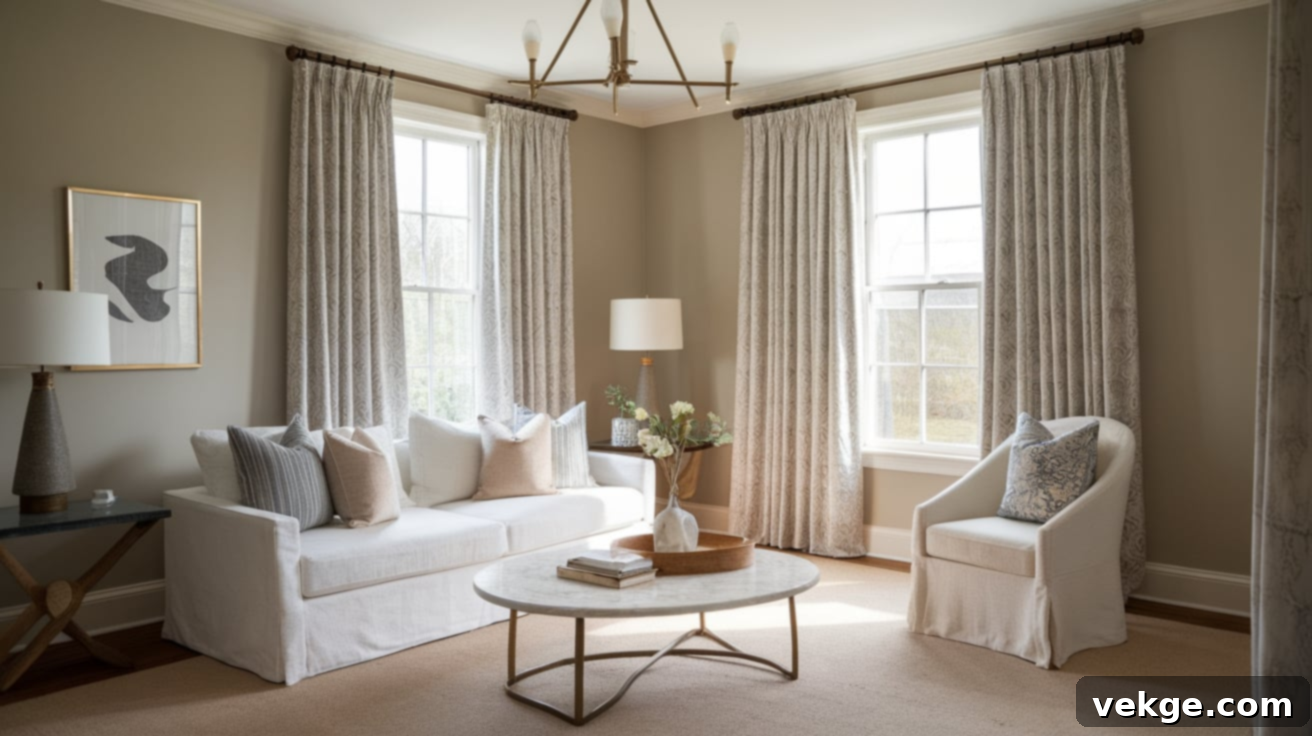
Ecru curtains provide a wonderfully warm, soft, and subtly sophisticated neutral alternative to pure white. With their delicate creamy and slightly beige undertones, they pair beautifully with gray walls by adding an instant layer of softness and gentle, inviting contrast. Ecru excels in traditional, farmhouse, or cozy modern homes seeking a gentle, layered aesthetic that feels both refined and comfortable.
This curtain color reflects light in a soft, diffused manner, contributing to a warm glow within the room, and pairs effortlessly with natural wood tones, elegant brass fixtures, and a variety of earth-toned decor elements. It’s a reliable and safe choice for virtually any room, offering immense flexibility and a timeless, classic appeal that manages to avoid feeling either too starkly bright or too predictably bland. Ecru brings a quiet elegance that truly enhances a gray-walled space.
Expert Styling Tips for Choosing Curtain Colors with Gray Walls
When curating the perfect curtain colors for your gray walls, a few strategic considerations can make all the difference, transforming your room from good to exceptional. Here’s how to refine your choices:
- Understand Gray’s Undertones: Gray is rarely just gray; it almost always has subtle undertones. It can be warm (leaning towards beige, brown, or even yellow) or cool (with hints of blue, green, or purple). Your chosen curtain color should ideally harmonize with these undertones. If your walls have a warm gray tone, consider pairing them with colors like mustard yellow, terracotta, or rich brown to enhance a cozy, inviting feel. For cool gray walls, shades like lavender, navy blue, or mint green will complement them beautifully and feel more natural and cohesive within the space.
- Consider the Room’s Lighting: The amount of natural light your room receives significantly impacts how curtain colors appear. Bright, sunlit spaces are forgiving and can comfortably handle darker, more saturated curtains—such as deep charcoal, dramatic navy, or even boldly patterned designs—without feeling enclosed or heavy. These choices can add striking style and depth. Conversely, in rooms with limited natural light, it’s always best to opt for lighter curtains—like crisp white, creamy ivory, or pale pastel tones. These lighter shades actively reflect available light, effectively creating a heightened sense of openness, airiness, and brightness.
- Balance with Patterns and Textures: Before introducing patterned curtains, take stock of your existing decor. If your walls already feature textured wallpaper, or your furniture boasts busy prints and intricate patterns, solid-colored curtains will provide a much-needed visual anchor, creating balance and preventing visual clutter. On the other hand, if your space is predominantly neutral, minimalist, or features solid colors, curtains offer an excellent opportunity to introduce captivating textures (e.g., velvet, linen, sheer) or subtle patterns. This approach adds depth, visual interest, and a layer of sophisticated complexity without making the room feel chaotic or overwhelming.
Common Mistakes to Avoid When Choosing Curtains for Gray Walls
While gray walls offer incredible versatility, making the wrong curtain choices can inadvertently disrupt the entire aesthetic of your space. Before finalizing your curtain selection, be sure to sidestep these common design pitfalls:
-
Ignoring Wall Paint Undertones: Gray is not a monolithic color; it encompasses a spectrum from warm (with beige, brown, or yellow undertones) to cool (with blue, green, or violet undertones). Choosing curtains with clashing undertones—e.g., warm curtains with cool gray walls, or vice versa—can make your room feel subtly off-balance and less harmonious. Always identify your gray’s undertone first.
-
Going Too Dark in a Dim Room: If your room receives minimal natural light, avoid heavy or excessively dark curtains such as deep charcoal, black, or navy. These can absorb precious light, making the space feel even gloomier and more enclosed. Instead, prioritize lighter options like crisp white, soft ivory, or sheer panels that allow light to filter through, enhancing brightness and openness.
-
Playing It Too Safe (Excessive Gray-on-Gray): While tonal layering can create a sophisticated, monochromatic look, overdoing gray without introducing contrast, texture, or varied shades can make a room feel flat, uninspired, and sterile. Don’t be afraid to introduce warmth with complementary colors or add visual interest with patterns and varying textures to prevent a bland outcome.
-
Choosing the Wrong Fabric Weight: The weight and material of your curtains greatly impact the overall feel. Heavy drapes might overpower a delicate, light gray wall, while flimsy, ultra-sheer curtains can look insufficient or out of place against a dark, moody gray. Match your fabric’s weight and opacity to your wall tone and the desired room style for a balanced look (e.g., heavy velvet for dramatic grays, light linen for airy grays).
-
Forgetting the Room’s Function: Curtains are more than just decorative. In a bedroom, for instance, blackout features for privacy and sleep are crucial. Living rooms might benefit from layered curtains (sheers plus heavier panels) to control light throughout the day. Always factor in practical needs like privacy, light control, insulation, and durability, not just aesthetic appeal, when making your choice.
-
Clashing with Existing Décor: Your curtains should not be a standalone feature. Ensure the chosen curtain color and style harmonizes well with your existing rugs, furniture, artwork, and other decorative elements. A curtain color that clashes with other prominent features can create a jarring, disconnected look, undermining the room’s overall coherence.
-
Buying Without Testing: Colors can look vastly different under various lighting conditions. Always acquire fabric swatches or small samples of your potential curtain choices and test them in your room. Observe how the color appears at different times of day—in natural light and under artificial lighting—before committing to a full purchase. This crucial step prevents costly disappointments.
